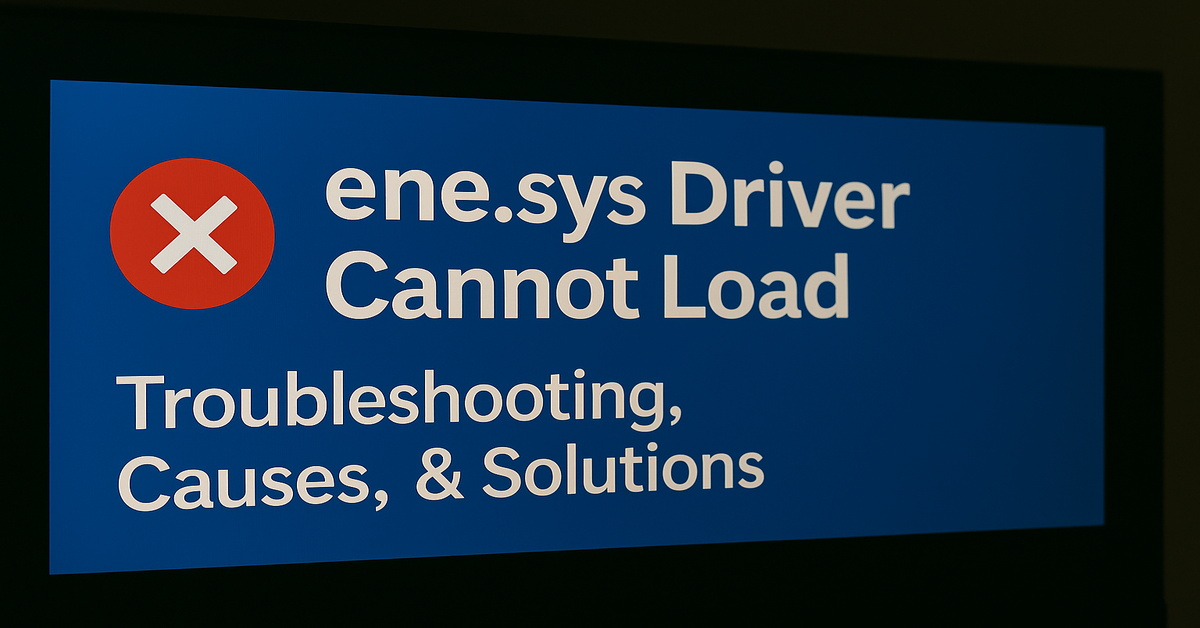What is ene.sys?
The ene.sys Driver Cannot Load is a system file commonly associated with certain hardware components and their control utilities—most notably related to RGB lighting control software such as MSI Mystic Light, ASUS Aura Sync, and other motherboard or peripheral lighting programs. It acts as a communication bridge between the operating system and the device’s embedded controller (EC), enabling functions like lighting customization or fan speed management.
What Does “Cannot Load ene.sys” Mean?
When users receive the error message “ene.sys driver cannot load,” it generally means the system failed to initialize the driver during startup or hardware communication. This may result in incomplete device functionality, missing lighting control, or instability in the software that relies on the driver.
Root Causes Behind the ene.sys Driver Error
Incompatible or Outdated Driver Versions
One of the most common reasons for this issue is using an outdated or incompatible version of the ene.sys driver with newer hardware or software updates.
Conflicting Software
Some lighting control applications from different manufacturers can conflict with each other, especially if multiple programs attempt to access the same hardware simultaneously.
Windows Updates
Windows system updates can sometimes cause drivers like ene.sys to become unstable or fail to load, particularly if system architecture changes or if driver signing policies are updated.
Corrupt Driver Files
A corrupted driver file—caused by abrupt shutdowns, malware, or faulty installations—can also prevent ene.sys from loading.
BIOS or Firmware Incompatibilities
Outdated motherboard firmware or BIOS can sometimes be at odds with driver versions, leading to load failures.
How to Identify the Issue
Error Messages
Users may see error dialogs on boot or while launching lighting software. The most common message is:
“The driver ene.sys cannot be loaded. Please reinstall or contact support.”
Event Viewer Logs
The Windows Event Viewer may contain system log entries under “System” or “Application” categories with references to ene.sys load failure.
Device Manager Status
Device Manager may flag related hardware (like EC controllers) with a yellow warning icon. Checking the “Properties” of these devices often reveals code errors or driver load issues.
Step-by-Step Troubleshooting
Step 1: Restart Your PC
Sometimes, a simple reboot can resolve temporary driver load problems.
Step 2: Check Windows Update
Ensure your Windows OS is up to date. Go to Settings > Update & Security > Windows Update and apply all available updates.
Step 3: Reinstall or Update RGB Control Software
If you use software like:
- MSI Mystic Light
- ASUS Armoury Crate
- ASRock Polychrome RGB
Download the latest version from the official website and reinstall it. This may include updated versions of ene.sys.
Step 4: Delete Corrupt Driver Files
- Boot into Safe Mode.
- Navigate to
C:\Windows\System32\drivers\. - Locate and delete
ene.sys. - Reinstall your control software to restore a fresh copy.
Step 5: Update BIOS/Firmware
Visit your motherboard manufacturer’s website and check for any available BIOS or EC firmware updates. Follow instructions carefully to apply the updates.
Step 6: Run System File Checker
Open Command Prompt as Administrator and run:
sfc /scannowThis will scan for and repair corrupt system files that might affect ene.sys.
Step 7: Disable Driver Signature Enforcement (Temporary Testing Only)
If ene.sys is unsigned or incorrectly signed:
- Enter Advanced Startup.
- Choose Startup Settings > Disable Driver Signature Enforcement.
- Boot and test if the driver loads.
Note: This is not a long-term fix. Only use for diagnosis.
Step 8: Contact Manufacturer Support
If the issue persists, reach out to the manufacturer of your motherboard or RGB device for driver-specific support.
Prevention and Best Practices
Avoid Installing Multiple RGB Suites
Stick to one lighting control suite at a time to avoid conflicts.
Keep Drivers and Software Updated
Regularly check for updates to your motherboard drivers, BIOS, and RGB software.
Use Verified Downloads
Only download drivers and utilities from official or reputable sources.
Create System Restore Points
Before making changes to drivers or firmware, create a restore point so you can roll back if something goes wrong.
Regularly Scan for Malware
Ensure malware hasn’t compromised your driver files or system functionality.
Advanced Fixes and Techniques
Clean Boot Troubleshooting
To isolate software conflicts:
- Open System Configuration (msconfig).
- Choose Selective Startup and uncheck Load startup items.
- Go to Services tab, check Hide all Microsoft services, then disable remaining items.
- Restart and test RGB software.
Registry Fixes (Advanced Users Only)
Improper registry entries related to ene.sys can cause load failures. Only modify the registry if you’re confident and have backups.
- Path to check:
HKEY_LOCAL_MACHINE\SYSTEM\CurrentControlSet\Services\ene.sys - Look for irregular startup type values or paths.
Log File Analysis
Use utilities like Process Monitor or Event Viewer to trace loading errors, permission denials, or blocked driver processes.
Use Cases Involving ene.sys
Gaming PC Builds
ene.sys is frequently bundled with software that controls RGB lights in custom gaming PCs. Any issue loading it can disrupt lighting synchronization.
Content Creation Rigs
Some creators use lighting for aesthetic control and brand consistency. If ene.sys fails to load, the visual experience suffers.
System Integrators
Prebuilt PC manufacturers may rely on ene.sys-dependent utilities to provide a complete end-user experience.
When to Disable ene.sys Altogether
Symptoms Warranting Removal
- Repeated BSODs linked to ene.sys.
- System instability even after driver reinstalls.
- No RGB features in use or needed.
Safe Removal Method
- Boot into Safe Mode.
- Remove related RGB software.
- Delete ene.sys from
System32/drivers. - Clean registry references.
- Reboot.
Warning: Make sure the driver is not essential for motherboard or device stability before removing.
Conclusion
The “ene.sys driver cannot load” error may seem daunting at first, but it is often solvable through methodical troubleshooting. From driver updates and software reinstallations to BIOS updates and safe mode diagnostics, multiple paths exist to address and resolve this issue. As RGB control becomes more widespread, understanding the components behind it—like ene.sys—can help users maintain system stability and aesthetics.
Staying proactive with driver management and avoiding software conflicts are key strategies for long-term reliability. Whether you’re a gamer, tech enthusiast, or IT professional, tackling ene.sys issues equips you with valuable knowledge of system-level hardware-software integration.
FAQs
1. What is the ene.sys driver used for?
It’s used by software controlling embedded controllers (EC), typically for RGB lighting or fan management on PCs.
2. Why is ene.sys failing to load on my system?
The failure may be due to driver corruption, Windows updates, conflicting software, or BIOS incompatibility.
3. Is it safe to delete ene.sys?
Yes, if you no longer use hardware or software that depends on it. Ensure it’s not critical to your system’s operation.
4. Can I reinstall ene.sys manually?
Yes, by reinstalling the software package that includes it—typically your motherboard’s RGB or fan control software.
5. Will this error affect my PC’s performance?
Usually no, but it may affect features like lighting or fan controls. In rare cases, it can cause instability.
6. How can I avoid this issue in the future?
Avoid conflicting RGB utilities, keep software updated, and create restore points before major updates or installs.











